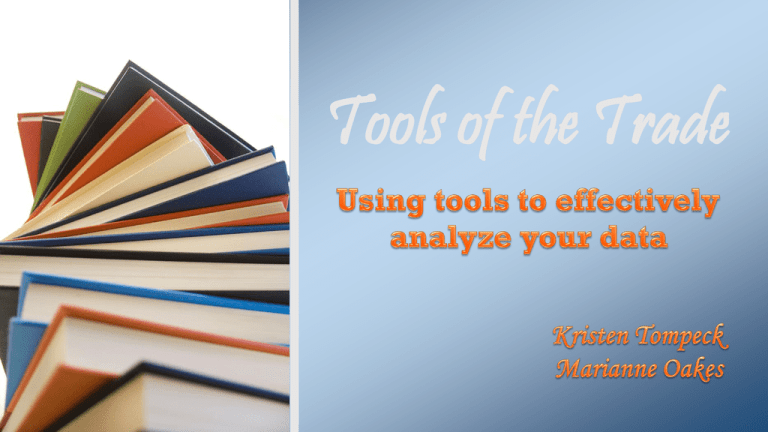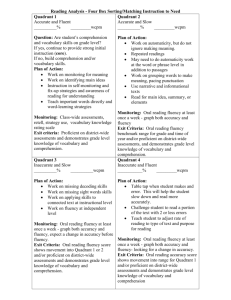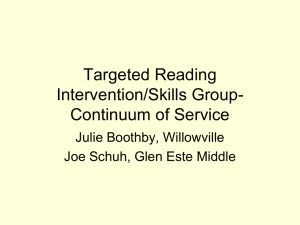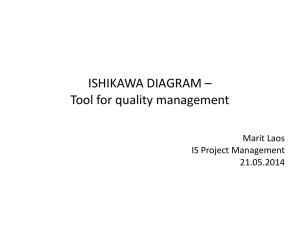The Tools
advertisement

Tools of the Trade Objectives • Share a variety of data analysis tools • Provide examples for each tool • Discuss the advantages and limitations of each tool Quick share What is the “state” of data at your school? Data User Stereotypes… Why use data in the first place? “An undefined problem has an infinite number of solutions.” Robert A. Humphrey Data gives us the What can we consider data? • Summative assessments (OAKS, report card grades, graduation rates) • Formative assessments (quizzes, exit tickets, homework • Classroom observations (running records, notecards, rubrics, etc.) • Attendance records • Behavior records, incident records, discipline referrals Improving Decision-Making via Problem Solving Problem Problem Solving (data analysis) Solution Action Planning & Evaluation What do the data say? 55% of fifth-grade Riverdell students are scoring below the 50th percentile on easyCBM PRF at Winter Benchmark. Primary 39 of 70 fifth-graders, or 55% are scoring below the 50th percentile on easyCBM PRF at Winter Benchmark. Skill deficits range from lack of prosody to the inability to read multi-syllabic words. Motivation does not appear to be an issue. Precise Break it down… Primary Jamaal is struggling to read second-grade material. Precise Jamaal is struggling to decode words with r-controlled vowels and multi-syllabic words. His fluency falls between 35 and 45 cwpm and is a product of his decoding issues. His phrasing is appropriate when he can read the words. Your turn… What additional data would you need to write a more precise statement?. • According to winter Benchmark data, the number of second-grade students at “some risk” of reading failure is increasing. • Some students at “low risk” in fluency do not have adequate comprehension. Data Considerations… What do we need to consider when working with data? Data Considerations • Do the data reveal patterns or trends? • Do the data raise new questions? • Do we need more information? • What about outliers or irregularities? • What cautions should be considered? The Tools: Process & Procedures • Wagon Wheel • Quadrant Analysis • Ishikawa Fishbone • Force Field Analysis Wagon Wheel Wagon Wheel • Gives big picture view • Compares many variables at once across several classrooms/grades • Visually depicts relationships among variables • Lots to discuss 6 70 60 50 40 30 20 10 0 1 2 Series 1 Series 2 Series 3 5 3 4 Wagon Wheel Procedure: 1. Determine variables, gather data 2. Set scale, phrase all performance standards so highest percent is the outer circle 3. Plot points, connect points for easier analysis Wagon Wheel Template Key Variables 8 2 2 7 3 1. 2. 3. 4. 5. 6. 7. 8. 3 Possibilities for Analysis 6 4 Wagon Wheel Template 5 •Grade level •Teachers •Student groups/subgroups •Domains/strands •Grades •Courses •Instructional Strategies-Training •Instructional Strategies-Implementation S - 27 •Years (trends) Classroom A Classroom B Classroom C 1 100% 90% 8 1)Students at Low Risk in winter 2 80% 2) Students making adequate progress 70% 60% 50% 3)Actual vs. allocated time 40% 30% 4)Time in small group instruction 20% 10% 7 3 0% 5)Lesson plans with active engagement 6)Instruction in 5 big ideas 7)Participation in grade-level collaboration 4 6 5 8)Objectives clearly articulated to students Other Charts Radar Wagon Wheel in Excel Quick Share How might you use this tool? Quadrant Analysis Quadrant Analysis • Student oriented • Indicates instructional groups Variable 2 • Compares two variables High/Low High/High Low/Low High/Low Variable 1 Quadrant Analysis 1. Choose two related variables, collect data 2. Use data to group students Variable 2 Procedure: High/Low High/High Low/Low High/Low Variable 1 Literacy Comprehension Quadrant Analysis High Comprehension./Low Fluency High Comprehension/High Fluency John Sally Bob Sandy Katie Angie Tony Kenny Steve Low Fluency/Low Comprehension High Fluency/Low Comprehension Sue Tom Billy Al Zane Maddi Joan Fluency Math Algebraic Thinking (OAKS) Quadrant Analysis High Comprehension./Low Fluency High Comprehension/High Fluency John Sally Bob Sandy Katie Angie Tony Kenny Steve Low Fluency/Low Comprehension High Fluency/Low Comprehension Sue Tom Billy Al Zane Maddi Joan Statistics (OAKS) Quick Share How might you use this tool? Ishikawa Fishbone Ishikawa Fishbone • Graphic organizer • Analyzes cause &effect relationships • Sorts causes into those we can affect and those we can’t • Identifies goal • Accessible Ishikawa Fishbone Procedure: 1. Identify area of weakness or desired outcome 2. Identify root causes 3. Determine teacher affected causes 4. Use identified causes to determine goals 5. “Catch & Release” Effect Determine area of concern or desired outcome Causes Identify causes, differentiate teacher affected causes Ishikawa Fishbone: Wallowa Quick Share How might you use this tool? Force Field Analysis Force Field Analysis • Identifies driving and restraining forces and related action steps • Prioritizes forces • Accessible, linear Force Field Analysis Procedure: Desired Change: Driving Forces 1. Define the desired change 2. Brainstorm driving and restraining forces 3. Prioritize forces 4. Identify action steps Action Steps: Restraining Forces Quick Share How might you use this tool? The Right Tool for the Job… Which tool would you choose? Why? Scenario 1 The math teachers administered the EasyCBM Fall Benchmark. Overall , students performed poorly and well below teacher expectations. The teachers are not sure where to begin. The Right Tool for the Job… Which tool would you choose? Why? Scenario 2 The high school English teachers have been working on writing intensively for the past month. One class continues to struggle to be as successful as the other classes and over the last three assessments, scored significantly lower. It is concerning the entire department. Tools: Advantages and Limitations Tool Wagon Wheel Advantages • • • • Big picture Clear visual to organize many variables Compare disparate pieces of data Illustrates relationships among variables Limitations • • • • Less precise Not used for analyzing causes Initially intimidating Need lots of data Quadrant Analysis • Illustrates related variables • Breaks students into groups instructional groups • Student oriented • Limited to two variables • Binary system (no middle ground) Ishikawa Fishbone • Cause & Effect analysis • Sorts causes into those we can effect and those we can’t • Most detailed view • accessible • Limited scope • May separate dependent variables Force Field • • • • Accessible More linear Clearly identified next steps “compare/contrast” • Limited scope Tools of the Trade Thank you! Marianne Oakes moakes@lesd.k12.or.us Kristen Tompeck ktompeck@wallowa.k12.or.us








